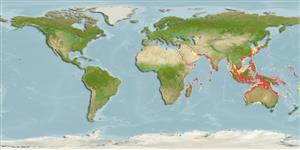分類 / Names
共通名の | 類義語 | Catalog of Fishes(部類, 種) | ITIS | CoL | WoRMS | Cloffa
>
Dactylopteriformes (Flying gurnards) >
Pegasidae (Seamoths)
Etymology: Pegasus: Taken form the winged horse of Perseus in the ancient Greek, mithology (Ref. 45335); volitans: From the Latin word 'volitans' meaning to fly.
More on author: Linnaeus.
Environment: milieu / climate zone / depth range / distribution range
生態学
海; 汽水性の 底生の; 深さの範囲 1 - 73 m (Ref. 11441), usually 9 - 27 m (Ref. 1418). Tropical; 36°N - 37°S
Indo-West Pacific: Delagoa Bay, Mozambique to Saudi Arabia (Persian Gulf) and throughout Gulf of Manaar to Bay of Bengal; along the east coast of Myanmar; north to Japan, south to tropical Australia (Ref. 1418) and Papua New Guinea (Ref. 6192).
サイズ / 重さ / 年齢
Maturity: Lm ? range ? - ? cm
Max length : 20.0 cm TL オス/雌雄の選別がない; (Ref. 90102)
背面の脊椎 (合計) : 0; 背鰭 (合計) : 5; 肛門の骨: 0; 臀鰭: 5; 脊つい: 21. Body light brown or olive to dark brown-black dorsally and laterally, lighter ventrally. Tubercles absent on surface of carapace; no scales on orbit; distal margin of dorsal and anal fins perpendicular to horizontal axis of body. 4 pairs of dorsolateral body plates; 5 pairs of ventrolateral body plates; tail rings 12, anteriormost 9 mobile, last 3 fused; a lateral pair of posteriorly directed spines on terminal tail rings; suborbital shelf convex obscuring eye from ventral view; deep pits absent. Rostrum monomorphic and spatulate.
A rare species (Ref. 4264) collected from muddy and sandy bottoms of estuaries and bays. Known to 'walk' over the bottom using its tentacular pelvic fins. Juveniles expatriate to tropical regions; adults mainly found in muddy estuaries where they pair. Sometimes they are seen partly buried but also feed during the day. Sometimes found floating on the surface (Ref. 48635). Sometimes occurs in seagrass areas (Ref 90102). Feeds on small benthic organisms (Ref. 68964).
Life cycle and mating behavior
成熟 | 繁殖 | 放精 | 卵 | 生産力 | 幼生
Palsson, W.A. and T.W. Pietsch, 1989. Revision of the Acanthopterygian fish Family Pegasidae (Order Gasterosteiformes). Indo-Pac. Fish. (18):38 p. (Ref. 1418)
IUCNのレッドリストの状況は (Ref. 130435: Version 2024-2)
Human uses
水産業: 商業
用具
特記事項
XMLをダウンロードして下さい
インターネットの情報源
Estimates based on models
Preferred temperature (Ref.
123201): 23.8 - 29.1, mean 28.1 °C (based on 1202 cells).
Phylogenetic diversity index (Ref.
82804): PD
50 = 0.5781 [Uniqueness, from 0.5 = low to 2.0 = high].
Bayesian length-weight: a=0.01000 (0.00244 - 0.04107), b=3.04 (2.81 - 3.27), in cm total length, based on all LWR estimates for this body shape (Ref.
93245).
栄養段階 (Ref.
69278): 3.5 ±0.37 se; based on food items.
Fishing Vulnerability (Ref.
59153): Low vulnerability (10 of 100).
